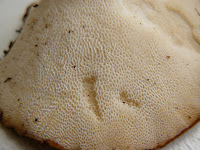First Mushroom
Date: 05/08/2010
Habitat: Specimen found growing alone on ground, near rotten wood and under a tulip tree ("tulip poplar").
Measurements:
Stipe (stem) length - 5.0 cm
Stipe diameter at apex - 2.0 cm
Stipe diameter at middel - 1.2 cm
Stipe diameter at base - 1.5 cm
Pileus (cap) diameter - 7.7 cm
Pileus legth - 1.5 cm
Description:
 Pileus cuticle (surface) brown and with a darker edge, with fine, short, soft and sparse fibrils (hair), margin is eroded and incurved (rolled downward), surface is dull, flesh is soft, white. Smell is not distictive but slightly sweet. Pileus is uplifted and shallowly depressed (center of pileus is deeper than borders). From the top, pileus is round. Taste is bland and not distinctive.
Pileus cuticle (surface) brown and with a darker edge, with fine, short, soft and sparse fibrils (hair), margin is eroded and incurved (rolled downward), surface is dull, flesh is soft, white. Smell is not distictive but slightly sweet. Pileus is uplifted and shallowly depressed (center of pileus is deeper than borders). From the top, pileus is round. Taste is bland and not distinctive.Hymenius (under side of the cap) is comprised of tightly attached tubes with round, white, pores, which do not bruise any color. Tubes are shallow (1-1.5 mm).
Stipe is central, solid, white, cartilagionous (brakes with a snap), when cut one can see small fibrils on border and dots inside, smell is agreeable but not distinctive. More importantly, stipe is radicated (continues as if it had a root) and pseudorhiza (root-like structure) is dark, convoluted and with multiple knots. Pseudorhiza is about 5 cm long. No ring (ring of tissue in stipe), veil (tissue covering pore surface) or volva (ring of tissue at stem base) were observed.
Spore print: could not obtain one.
Impressions: Given that specimen has "roots", spore surface is tightly attached and that it was found alone and near decaying woods, it suggests that this speciment is a Polyporus radicatus (Schwein.) Fr. The important things for identification here are the combination of a ground growing polypore with dark, convoluted pseudorhiza and thin tightly attached tubes. This is not an edible mushroom.
Note: After sequencing the intergenic region 1 (ITS1) of this mushroom I got a 98% match to Polyporus tuberaster. Apparently there is no sequence deposited for Polyporus radicatus and these two polyporus are very similiar to each other.
The sequence obtained was: GCCGAWCCGCAAGGAACCAAGCTAATGCATTTGAGAGGAGTCGACAATCGCCGACAAAAGCCTCCAAAGTCCAAGCCTTACAAAGACCACAAGGATCTTGCAGGTTGAGAATTTCATGACACTCAAACAGGCGTGCTCCTCGGAATGCCAAGGAGCGCAAGGTGCGTTCAAAGATTCGATGATTCACTGAATTCTGCAATTCACATTACTTATCGCATTTCGCTGCGTTCTTCATCGATGCA
See the result of the BLAST below:
gb|AF516594.1| Polyporus tuberaster CulTENN10316 SBI 1 18S ribosomal RNA gene, partial sequence; internal transcribed spacer 1, 5.8S ribosomal RNA gene and internal transcribed spacer 2, complete sequence; and 28S ribosomal RNA gene, partial sequence Length=988 Score = 573 bits (310), Expect = 2e-160 Identities = 330/340 (97%), Gaps = 2/340 (0%) Strand=Plus/Plus Query 3 ATTCAGTGAATCATCGAATCTTTGAMCGCACCTTGCGCTCCTTGGCATTCCGAGGAG-AG 61 ||||||||||||||||||||||||| ||||||||||||||||||||||||||||||| | Sbjct 627 ATTCAGTGAATCATCGAATCTTTGAACGCACCTTGCGCTCCTTGGCATTCCGAGGAGCAC 686 Query 62 GACTGTTTGAGTGTCATGAAATTCTCAACCTGCAAGATCCTTGTGGTCTTTGTAAGGCTT 121 | ||||||||||||||||||||||||||||||| |||||||||||||||||||||||||| Sbjct 687 GCCTGTTTGAGTGTCATGAAATTCTCAACCTGCGAGATCCTTGTGGTCTTTGTAAGGCTT 746 Query 122 GGACTTTGGAGGCTTTTGTCGGCGATTGTCGACTCCTCTCAAATGCATTAGCTTGGTTCC 181 |||||||||||||||||||||||||||||||||||||||||||||||||||||||||||| Sbjct 747 GGACTTTGGAGGCTTTTGTCGGCGATTGTCGACTCCTCTCAAATGCATTAGCTTGGTTCC 806 Query 182 TTGCGGATCGGCTTTCGGTGTGATAGTTGTCTACGCCGTGACCGTGAAGCGTTTTGACTA 241 |||||||||||||||||||||||||||||||||||||||||||||||||||||||| | | Sbjct 807 TTGCGGATCGGCTTTCGGTGTGATAGTTGTCTACGCCGTGACCGTGAAGCGTTTTGGCGA 866 Query 242 GCTTCTAATCGTCTCGTTCGAGACTCATTCTTCATTGACATCTGACCTCAAATCAGGCGG 301 |||||||| |||||||||||||||| ||||||||| |||||||||||||||||||||||| Sbjct 867 GCTTCTAACCGTCTCGTTCGAGACTTATTCTTCAT-GACATCTGACCTCAAATCAGGCGG 925 Query 302 GACTACCCGCTGAACTTAAGCATATCAATAAGCGGAGGAA 341 |||||||||||||||||||||||||||||||||||||||| Sbjct 926 GACTACCCGCTGAACTTAAGCATATCAATAAGCGGAGGAA 965








No comments:
Post a Comment